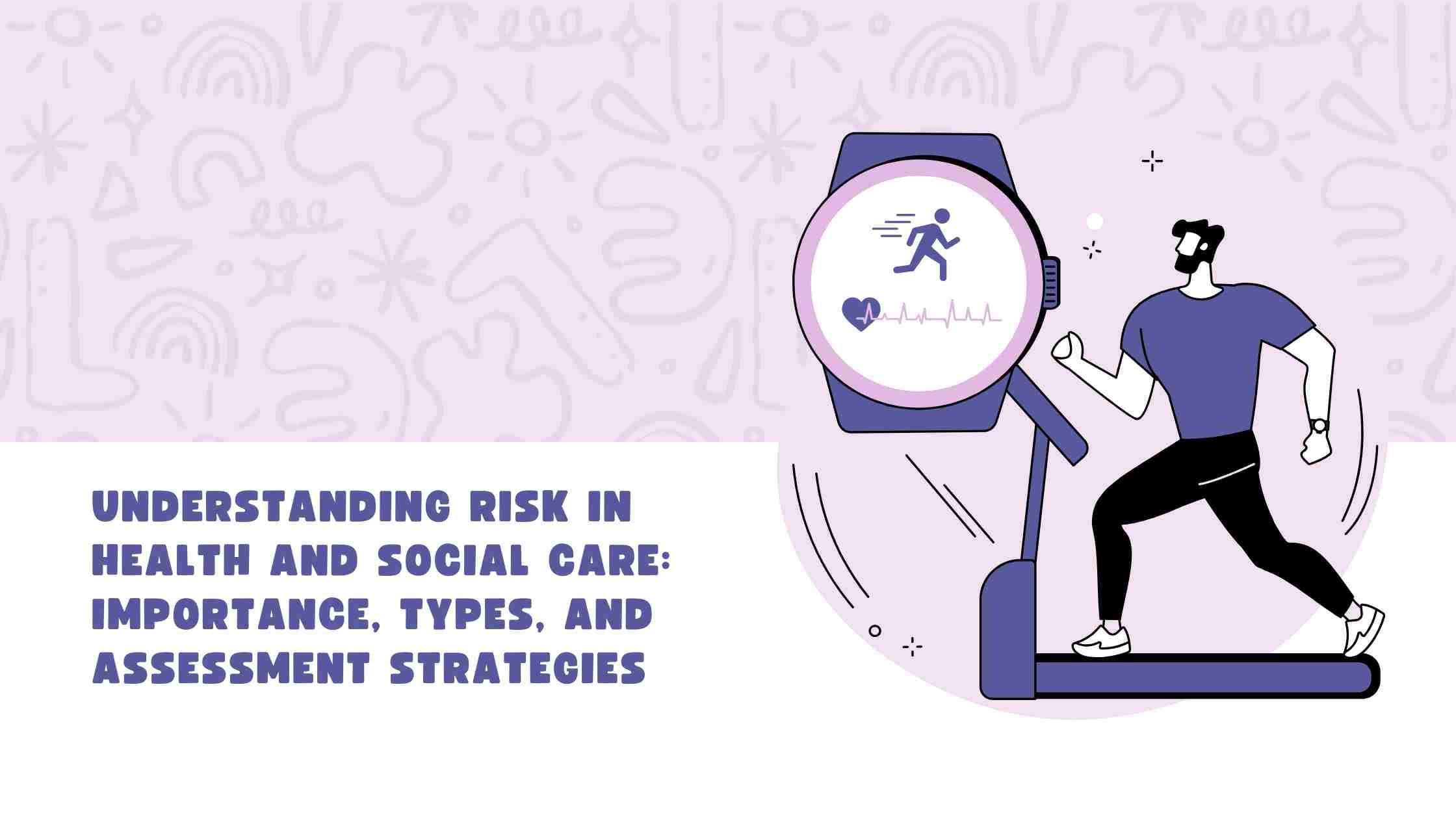What is a Risk in Health and Social Care? Importance, Types, and Assessment Strategies
Introduction
Health and social care are inherently risky fields that affect both service providers and recipients. Effective risk assessment and management are essential for minimizing risks, protecting vulnerable people, and guaranteeing patient safety.
The topic of risk in health and social care, its various forms, risk assessment examples, and methods for creating a safe care environment are all covered in this article.
What is a Risk in Health and Social Care?
Risk is the possibility of injury or unfavorable consequences for patients, healthcare providers, and service users in the context of health and social care. Medical procedures, environmental dangers, psychological aspects, or operational difficulties can all provide risks.
Common Risks in Health and Social Care
- Physical risks – Falls, infections, medication errors
- Psychological risks – Mental distress, emotional harm, discrimination
- Environmental risks – Poor hygiene, unsafe equipment, fire hazards
- Operational risks – Lack of staffing, training gaps, communication failures
Understanding and mitigating risks improves care quality and ensures regulatory compliance.
Types of Risk in Health and Social Care
Risk assessment involves identifying different types of risks that could impact patients, caregivers, and healthcare systems.
1. Clinical and Medical Risks
- Medication errors – Incorrect dosage or prescribing the wrong medication
- Infections and diseases – Cross-contamination and lack of hygiene control
- Surgical complications – Adverse reactions to anesthesia, post-operative infections
2. Physical and Environmental Risks
- Falls and injuries – Elderly and disabled individuals are at higher risk
- Fire hazards – Electrical faults, poorly maintained equipment
- Unsafe equipment – Faulty medical devices and assistive technology
3. Psychological and Emotional Risks
- Mental health deterioration – Anxiety, depression, PTSD
- Bullying and discrimination – Abuse from caregivers or peers
- Social isolation – Lack of engagement, loneliness among elderly residents
4. Financial and Organizational Risks
- Understaffing and burnout – Increased workload leads to poor patient care
- Lack of funding – Reduced services and resource limitations
- Legal and compliance risks – Failing to meet Care Quality Commission (CQC) guidelines
Understanding these risks helps care providers implement effective prevention strategies.
What is Risk Assessment in Health and Social Care?
Risk assessment is a structured approach to identifying potential hazards and implementing measures to reduce harm.
Read More: What is a Risk Assessment in Health and Social Care?
Key Components of Risk Assessment
- Identify potential risks – Recognizing hazards in care environments
- Evaluate who may be affected – Assessing vulnerable individuals (elderly, disabled, children)
- Analyze the level of risk – Determining the likelihood and severity of harm
- Implement preventive measures – Reducing or eliminating identified risks
- Monitor and review – Regularly updating risk management strategies
Risk assessment is essential for ensuring patient safety, meeting legal standards, and improving service quality.
Examples of Risk Assessment in Health and Social Care
1. Risk Assessment in Nursing and Hospitals
| Risk | Example |
| Medication errors | Nurses must double-check prescriptions and administer the correct dosage. |
| Patient falls | Installing handrails and slip-resistant flooring to prevent falls in elderly care units. |
| Infection control | Implementing hand hygiene protocols to prevent hospital-acquired infections. |
2. Risk Assessment in Care Homes
| Risk | Example |
| Fire hazards | Conducting fire safety drills and installing emergency exits. |
| Nutritional risks | Ensuring dietary plans meet residents’ health conditions. |
| Mental well-being risks | Encouraging social interaction and mental stimulation activities. |
3. Risk Assessment in Community-Based Care
| Risk | Example |
| Home safety | Assessing trip hazards and home modifications for elderly patients. |
| Social isolation | Organizing community events and support groups for mental well-being. |
| Transportation risks | Providing safe transport for individuals with mobility challenges. |
Effective risk assessments minimize harm and enhance patient safety.
Types of Risk Assessments in Health and Social Care
There are several approaches to conducting risk assessments based on specific needs and care environments.
1. Generic Risk Assessment
- Conducted across all care settings to identify general hazards.
- Example: Fire risk assessment in hospitals and nursing homes.
2. Individual Risk Assessment
- Focuses on specific individuals’ needs and vulnerabilities.
- Example: Fall prevention assessment for an elderly patient.
3. Dynamic Risk Assessment
- Involves real-time hazard identification during emergencies.
- Example: Assessing risk during an unexpected patient aggression event.
4. Manual Handling Risk Assessment
- Ensures safe lifting and transferring of patients.
- Example: Using hoists and assistive devices for disabled individuals.
Why is Risk Management Important in Health and Social Care?
Effective risk management protects patients, caregivers, and organizations.
1. Ensuring Patient and Staff Safety
- Reduces accidents, infections, and medical errors.
- Prevents workplace injuries for healthcare staff.
2. Compliance with UK Healthcare Regulations
- Meets Care Quality Commission (CQC) standards.
- Avoids legal consequences and fines.
3. Enhancing Quality of Care
- Promotes proactive safety culture.
- Builds trust and confidence among service users.
4. Reducing Costs and Legal Liabilities
- Minimizes compensation claims due to negligence.
- Saves healthcare resources by preventing avoidable incidents.
How to Improve Risk Management in Healthcare?
1. Staff Training and Awareness
- Conduct regular workshops on risk assessment procedures.
- Train staff in handling emergency situations effectively.
2. Implementing Technological Solutions
- Use electronic patient records for improved risk monitoring.
- Install fall detection systems in elderly care facilities.
3. Encouraging Open Communication
- Promote a culture of reporting safety concerns.
- Encourage patients and families to provide feedback.
4. Regular Risk Audits and Monitoring
- Conduct routine safety inspections.
- Update policies based on new healthcare challenges.
FAQs on Risk in Health and Social Care
1. What is an example of a risk in social care?
A risk in social care could be a resident in a nursing home falling due to a lack of mobility support.
2. What are the legal requirements for risk assessment in healthcare?
Under the Health and Safety at Work Act 1974, healthcare providers must assess, record, and manage risks to ensure safety.
3. Can risk assessments prevent accidents in care homes?
Yes, proactive risk assessments reduce accidents by identifying hazards and implementing preventive measures.
4. What tools are used for risk assessment in nursing?
Common tools include:
- Fall Risk Assessment Tool (FRAT)
- Manual Handling Risk Assessment Checklists
- Patient Safety Incident Reports
5. How often should risk assessments be conducted in hospitals?
Hospitals should perform regular risk assessments at least every 6–12 months or whenever a new risk emerges.
Conclusion
In order to guarantee patient safety, regulatory compliance, and high-quality service delivery, risk assessment is crucial in the health and social care sectors. Healthcare organizations can put into practice efficient measures to reduce harm and improve care outcomes by detecting hazards early.
To safeguard patients and establish a secure, encouraging care environment, healthcare providers must continue to be watchful, knowledgeable, and proactive in identifying dangers.







